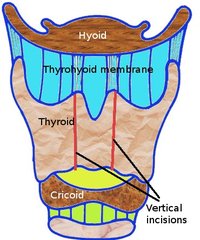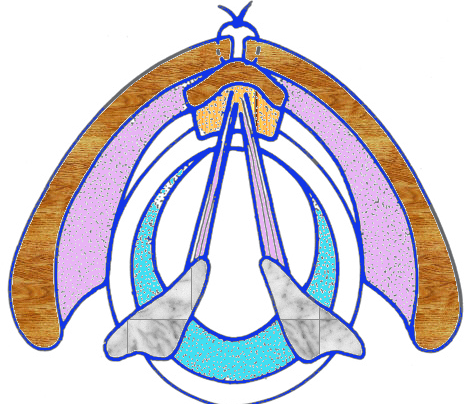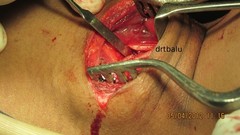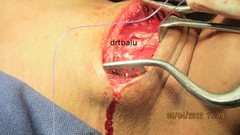Surgical management of puberphonia
Complaints:
20 years old male patient came with complaints of :
Persistence of feminine voice On examination:
Patient had feminine voice. Gutmann's test Positive
This test is performed by applying anterior pressure to thyroid cartilage. Patient is asked to speak. If the voice reverts to normal male voice then it is supposed to be positive.
Video laryngoscopy: Normal study
Past history:
Patient gave no history of delay in development of secondary sexual characteristics.
Management:
Patient was treated with speech therapy. Even 6 months after starting the treatment patient showed no improvement in voice.
Patient was taken up for retrusion thyroplasty. This is actually one form of Ishikii type III thyroplasty.
Anaesthesia: Local anaesthesia
Incision: Skin crease incision at the level of lower border of thyroid cartilage.
Skin flap is raised in the subplatysmal plane up to the level of hyoid bone. Whole of the thyroid cartilage was skeletonized. Perichondrium over thyroid cartilage was incised via a midline incision. Perichondrial flaps are thus elevated. Two vertical incisions are made one on either side of midline of thyroid lamina. This leads to a thin strip of midline cartilage which is gently pushed inside causing relaxation of vocal folds. The free ends of thyroid cartilage is then sutured back in position with non absorbable sutures after ascertaining voice change is adequate.
Discussion:
The persistence of adolescent voice even after puberty in the absence of organic cause is known as Puberphonia. This condition is commonly seen in males. This is uncommon in females because laryngeal growth spurt occurs commonly only in males. According to Banerjee the incidence of Puberphonia in India is about 1 in 900,000 population. Pathophysiology:
In infants the laryngotracheal complex lies at a higher level. It gradually descends. During puberty in males this descent is rapid, the larynx becoming larger and unstable and on top of it the brain is more accustomed to infant voice. The boy may hence continue to use a high pitched voice or it may break into higher and lower pitches. Etiology:
1. Emotional stress
2. Delayed development of secondary sexual characters
3. Psychogenic
4. Hero worship of older boy or sibling
5. Excessive maternal protection
6. Non fusion of thyroid laminae
Examination of these patients should include a complete physical examination including a genital examination also. Secondary sexual characters should be assessed, hypogonadism should be ruled out. A complete psychological profile of the patient in question should be built to rule out psychological causes. If psychological causes could be identified they treating it should take precedence over other modalities.
Conclusion:
This patient benefited from this surgical procedure. Surgery should be resorted to only if all conservative means of treating puberphonia fails. Speech therapy should be given adequate try before resorting to surgery.





